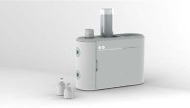Fraunhofer ITEM takes over and continues development of inhalation technology assets from Takeda

The transfer includes the CPA technology for continuous aerosolization of powdery substances and the know-how to manufacture recombinant surfactant protein C, together with the associated intellectual property. The Fraunhofer ITEM is thus in a position to continue the development of therapies involving continuous inhalation various medications, begun 10 years ago.
Closing down its respiratory department, Takeda transferred its Surfactant and CPA program assets to Fraunhofer ITEM including the associated intellectual property. The CPA technology is the first non-invasive administration method for powdery surfactant drugs.
Surfactant drugs have to be administered to patients with surfactant deficiency, which is common, for example, in preterm in neonates. Furthermore, this therapeutic approach has been investigated in other acute and chronic life-threatening diseases such as acute lung injury and COPD.
Surfactant (“surface-active agent“) is secreted by certain lung cells und reduces surface tension in the alveoli, thereby preventing their collapse. Physical activity causes an increase, smoking a decrease in surfactant production. Fetal surfactant production starts in week 24 of gestation. Preterm neonates, in particular if born before week 34 of gestation, suffer from varying degrees of pulmonary surfactant deficiency, which may lead to neonate respiratory distress syndrome.
Surfactant-based therapy is the standard of care. Its use is limited, however, due to the currently invasive administration methodology. The CPA technology simplifies surfactant delivery to neonates and can also be used for children and adults. Recombinant surfactant protein C is the first recombinant surfactant protein suitable for use in synthetic surfactant drugs.
CPA is also a suitable technology to continuously deliver pulmonary high doses of non-soluble drugs to patients. In respiratory care, the standard of aerosolization for continuous inhalation is currently confined to different classes of nebulizers. In contrast, the CPA technology for the first time enables continuous inhaled administration of non-soluble drugs. In addition, it delivers a higher drug concentration to patients and enables a higher lung deposition rate.
Dr. Gerhard Pohlmann, Head of Medical Inhalation Technology at Fraunhofer ITEM with a 10+ year track record in CPA technology development, said: “As a long-standing partner in the CPA program, Fraunhofer ITEM is delighted to continue development of the surfactant and CPA technology platform. We are currently in the strategic process of reorganizing the program and selecting development partners.”
Contact
Fraunhofer ITEM
Dr. Gerhard Pohlmann; +49 511 5350-116
gerhard.pohlmann@item.fraunhofer.de
Press contact
Fraunhofer ITEM
Dr. Cathrin Nastevska; +49 511 5350-225
cathrin.nastevska@item.fraunhofer.de
The text of this press release can be found on our homepage at
http://www.item.fraunhofer.de/en/press-media/latest-news/pm-CPA-takeda.html
Media Contact
All latest news from the category: Medical Engineering
The development of medical equipment, products and technical procedures is characterized by high research and development costs in a variety of fields related to the study of human medicine.
innovations-report provides informative and stimulating reports and articles on topics ranging from imaging processes, cell and tissue techniques, optical techniques, implants, orthopedic aids, clinical and medical office equipment, dialysis systems and x-ray/radiation monitoring devices to endoscopy, ultrasound, surgical techniques, and dental materials.
Newest articles

NASA: Mystery of life’s handedness deepens
The mystery of why life uses molecules with specific orientations has deepened with a NASA-funded discovery that RNA — a key molecule thought to have potentially held the instructions for…

What are the effects of historic lithium mining on water quality?
Study reveals low levels of common contaminants but high levels of other elements in waters associated with an abandoned lithium mine. Lithium ore and mining waste from a historic lithium…

Quantum-inspired design boosts efficiency of heat-to-electricity conversion
Rice engineers take unconventional route to improving thermophotovoltaic systems. Researchers at Rice University have found a new way to improve a key element of thermophotovoltaic (TPV) systems, which convert heat…



